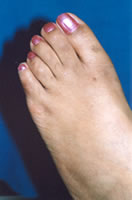Diabetic peripheral neuropathy is multifaceted and does not only cause pain in the feet toes and hands, it will also cause an intense burning pain, numbness, tingling, and parasthesias to name only a few neurological symptoms that can lead to such disastrous ends. For this reason, it is especially important for the diabetic patient who routinely can experience nerve damage in their feet, to have his or her lower extremity nerves tested at least once a year. Screening with the mono-filament test that doctors have been using, is inaccurate and can give false results causing one to believe that there is no nerve damage while the diabetic patient is on the verge of physical disaster.
It is this type of insidious nerve damage in the diabetic that is responsible for the majority of the atraumatic amputations. Atraumatic amputation refers to that type of amputation that is not the result of an auto accident, or gunshot wound, etc. These amputations have usually very little to do with poor circulation. Poor circulation along with the loss of protective nerve sensation (peripheral neuropathy), certainly speeds up the probable.
Advanced Surgery Workshop
Dr. Neil L. Horsley completed the Advanced Surgery Workshop at the Institute for Peripheral Nerve Surgery. This intensive workshop was offered at the Johns Hopkins Medical Center in Baltimore, MD, December 12 - 14 2001.
The workshop is the brainchild of Dr. A. Lee Delon, Professor of Hand, Plastic and Neurosurgery. Dr. Delon developed the research, testing instruments and surgical techniques over the last 25 plus years.
However, nerve damage alone in the presence of excellent circulation can lead to atraumatic amputation. Why and how does this happen? Those high pressure areas on the bottoms of the feet where calluses form or those areas on the toes where corns form or where ingrown toenails exist, are the same areas that eventually break down and cause sores on the feet known as ulcerations.
Once the ulcer forms on the foot, the patient has an open porthole for bacteria to enter the body and potentially infect the bone. Once this happens, gangrene is not far away. The foot may be red, feel warm, swell and may ooze fluids while these infectious conditions are present.
There is a separately identifiable atraumatic amputation that is caused by poor circulation alone. These types of amputations caused by poor circulation are the usual results of smoking, hereditary vascular disease, poor dietary habits (such as greasy foods and a diet high in dietary fats and cholesterols), systemic conditions that have vascular problems and aging factors.
With poor circulation conditions the foot feels usually cool or cold and sometimes the skin color is dusky, gray or cyanotic (bluish). These circulatory conditions may be accompanied by the inability to walk more than a block before experiencing severe leg pain or cramping that is relieved by rest. If rest does not relieve the pain then the condition is very serious and requires vascular consultation immediately.
Diabetic peripheral neuropathy is reversible and when successful, can restore up to 100% of the normal nerve sensation. These surgical procedures are very precise and are designed to address those specific nerves that are directly related to the sensory changes.
The first step is the nerve testing. The Nerve Sensory Testing device is called the Pressure Specific Sensory Device (PSSD). It is a painless test that is done in a comfortable setting where you are completely relaxed.
It is important to stress that there is no pain involved concerning taking this test. The results of the test are then clinically correlated and a determination can be made to recommend the surgical procedures or other state of the art forms of currently used modes of therapy.
For more information on this subject, or to schedule an appointment with a footDrHorsley Podiatrist, please call (877) 372-6048
If you are experiencing any of the symptoms addressed, we strongly recommend that you seek the advice of your podiatrist for proper diagnosis.



